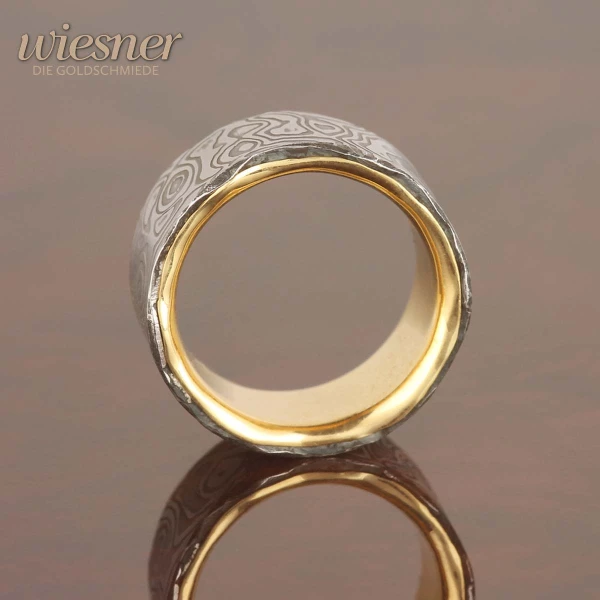Damascus steel rings - a special kind of wedding ring
The choice of wedding rings is an important part of the wedding preparations. The rings symbolize love and the bond between two people and are worn for a lifetime. For this reason, many couples opt for a special material and design that reflects their personality and relationship. An increasingly popular material for wedding rings is damask steel, or damask steel rings.
What is damask steel?
Damascus steel is a special type of steel that is created by welding and hammering different metals together. These metals are placed on top of each other in several layers and welded together. By repeating this process, a new block of raw material is created from which the wedding rings are made.
The art of Damascus steel dates back to ancient times, when it was mainly used for swords and other weapons. The layers of different metals ensured that the weapons were highly stable and strong. Today, Damascus steel is used for various applications, including the manufacture of wedding rings, due to its special pattern and strength.
Damascus steel rings from our workshop
Damascus steel rings with wood pattern with slight eye formation and silver inner ring
Uniqueness and distinctiveness of these rings
Each damask steel ring is unique, as the pattern and grain of the surface is one of a kind. This is due to the fact that the material is processed differently in each layer by welding and hammering. This means that no two rings are the same. The uniqueness and distinctiveness of Damascus steel rings emphasizes the individuality of the relationship between the partners.
Another advantage of Damascus steel rings is their extreme durability and scratch resistance. Due to the previous processing, damask steel is extremely robust and can be worn for a lifetime.
Design options for damascus steel rings
The pattern of the damask steel can be influenced by various techniques and processes. For example, rings with a wood pattern are created, which are perfectly accentuated by a slight eye formation and a silver inner ring. Other patterns, such as spirals or waves, are also possible. The colors of the rings vary depending on the metals used and can range from silver-grey to dark grey or even black.
The wedding ring is a symbol of love and the bond between two people. However, a damask steel ring not only symbolizes the bond between the partners, but also their individuality and uniqueness. Each ring is unique and therefore emphasizes the uniqueness of the relationship. With its durability and scratch resistance, it is a ring for life.
Search for and find good damask steel rings
If you are looking for a special and unique wedding ring, you should opt for damask steel. There are only a few good suppliers of damask steel rings, which are available in various designs and patterns.
Damascussteel rings made from meteorite and iron ore of the earth. "Heaven and earth"
The original meaning of a wedding ring was to publicly profess the bond.
The basic message has not changed much since ancient times, but the meaning of the wedding ring has evolved. While the first wedding rings were still made of simple iron, today the wedding rings on the couple's fingers reflect the perceived importance of the marriage and the relationship to each other. Over time, the simple wedding ring developed into an elaborately crafted ring using precious metals. Nowadays, couples strive to have their wedding ring made as a unique piece. This should emphasize the uniqueness and distinctiveness of their relationship.
Open damask steel rings with a yellow gold inner ring - a great contrast
What exactly is damask steel
Damascus steel is a term that is often used in connection with high-quality knives and other handmade products. But what exactly is Damascus steel and what makes it so special? In this article, we will take a look at the definition, the origin of the name "damascus", the characteristics and properties of damascus steel and the special features of damascus forging.
Definition of damask steel:
Damascus steel is a type of steel that is produced by forging several layers of different steels. These layers are welded together to create a material with unique properties. Damascus steel has a characteristic pattern that is created by the different layers and the forging process.
The origin of the name "Damascus":
The term "damask" dates back to the Middle Ages and refers to a textile fabric that was produced in the city of Damascus. This fabric had a characteristic pattern that resembled the pattern of damask steel. Over time, the term was applied to the forging of steel, which has a similar pattern.
Characteristics and properties of Damascus steel:
One of the outstanding characteristics of Damascus steel is its hardness and sharpness. This is due to the fact that the many layers of steel result in a high density and strength. Damascus steel is also very corrosion-resistant and durable due to the different layers.
The characteristic pattern of Damascus steel also makes it visually appealing and desirable. The pattern can vary depending on the method of production and the number of layers, ranging from wavy patterns to complex designs.
The special features of damask forging:
Damascus steel making is an art form performed by skilled blacksmiths. Damascus steel forging requires a high level of craftsmanship and experience. There are various techniques used by blacksmiths to create the characteristic pattern of Damascus steel.
One technique is the so-called "folding", in which the layers of steel are folded several times and welded again to reinforce the pattern. Another technique is the forging of different types of steel to create a pattern that is created by the different colors and hardnesses of the steels.
Yellow gold inner ring in Damascus steel rings - A great contrast and maximum wearing comfort
History and origin of damask steel
Steel is an important material that has been used for thousands of years. However, there is a special type of steel that stands out due to its unique pattern and hardness - damask steel. In this article, we take a look at the history and origins of Damascus steel, from the earliest developments of steel to its modern use.
The earliest developments of steel:
The history of steel dates back to ancient times, where it was first used as a material for weapons and tools. The earliest forms of steel were produced by forging iron at high temperatures to obtain a harder and more resistant alloy. Over time, various methods of steel production were developed, including the Bessemer process and the Siemens-Martin process in the 19th century.
The origin of Damascus steel:
The origin of Damascus steel can be traced back to the 4th century AD, when it was first produced in India. There it was called wootz steel and was known for its hardness and unique pattern. The process for making wootz steel was secret and was passed down from generation to generation by the blacksmiths.
The spread of Damascus steel in the Middle Ages:
In the Middle Ages, damask steel was perfected by Arab blacksmiths and then spread to Europe via the Silk Road. There, damask steel was used in particular for the manufacture of swords and knives. The unique pattern of the steel was created by folding and forging the steel, forming different layers and patterns.
Renaissance of damask forging:
In the 16th century, the art of damask forging experienced a renaissance in Europe. Damascus blades for swords, daggers and knives were produced in Germany and Italy in particular. The art of forging damask steel became an important skill that was passed on from master to apprentice.
Damascus steel in the modern age:
Damascus steel also plays an important role in modern times. It is still used for the production of high-quality swords, knives and other tools. The process of making Damascus steel has evolved over time and there are now different methods to achieve the unique patterning.
















